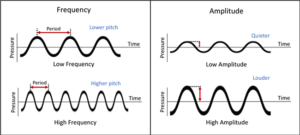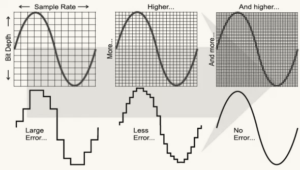Decoding the Dynamics of Audio

In the realm of entertainment, the journey from the analog era to the digital age has been transformative. We’ve evolved from the days of TV, radio, records, tapes, and books to embrace the digital revolution ushered in by CDs, home computers, and the internet. However, this transition wasn’t without its debates, especially in the 80s and 90s, when musicians and producers deliberated over the merits of analog versus digital recordings. Fast forward to today, digital audio stands as the undisputed standard, having triumphed over initial doubts through technological advancements.
Audio can be represented in two forms: Analog and Digital.
Sound, a series of waves, traverses through the air. The magic happens when a microphone converts these waves into electricity. The strength of this electricity corresponds to the loudness of the sound (amplitude), and it faithfully maintains the up-and-down pattern of the original sound (frequency).
The journey of analog sound into the digital realm involves a fascinating process of taking samples at a regular rate, known as the sample rate or sampling rate. These samples are captured with a specified level of detail, expressed as the number of bits per sample, famously known as the bit-depth.
Analog Audio Basics
In our daily auditory adventures, the sounds we hear are a dance of vibrations in our eardrums, creating symphonies as they traverse through the air. Let’s embark on a journey into the foundational principles of digital audio, beginning with two key players: amplitude and frequency.
Amplitude:
Amplitude, the powerhouse of sound, signifies the intensity of expansion and compression experienced by the medium, usually air. Measured in decibels (dB), it’s the magic ingredient that directly influences our perception of loudness. The rule is simple: the higher the amplitude, the louder the sound.
Frequency:

Frequency, the maestro of pitch, measures the number of vibrations experienced by the medium in a second, quantified in hertz (Hz). It dictates the pitch of a sound.
Here’s a fun fact sounds with low frequency are intrepid travelers, covering more ground than their high-frequency counterparts. For instance, the drumbeat’s frequency takes a leisurely stroll compared to the swift flight of a flute.
Humans are gifted with the ability to hear frequencies between 20 Hz and 20,000 Hz. Anything beyond 20,000 Hz is an ultrasound, and anything below 20 Hz is an infrasound, a mystical realm beyond our auditory reach.
Digital Audio Basics:
In digital conversion, analog signals are turned into binary language (zeros and ones) that computers can understand. This process involves sampling or measuring the analog signal at regular intervals to make it readable and editable in a computer system.
The digitization process involves various user-defined settings that affect aspects like frequency range, dynamic range, file size, and quality. Two key settings to consider are the sampling rate and bit depth (or resolution).
Sampling stands for the number of samples (amplitude values) captured at regular time intervals. The sampling rate is number of samples taken per second which is measured in Hertz (Hz).
Bit-depth represents the quantity of bits allocated per sample.

Why “Digital Audio”?
“Digital Audio” is the magic that transforms audio signals into a format that computers can comprehend and process. This requires the conversion of data into a digital (binary) form. Picture this: analog audio signals, typically continuous sinusoidal waves, transform into discrete points in the digital realm. These points represent the amplitude of the waveform, and this conversion from continuous to discrete is fundamental for computer utilization, providing finite, countable values within specific time intervals, aligning seamlessly with computational needs.
In conclusion, the decoding of digital audio opens a gateway to understanding the intricacies that shape the way we experience and interact with sound. It’s a symphony of technology and artistry, where the past meets the future in a harmonious blend of analog roots and digital possibilities.